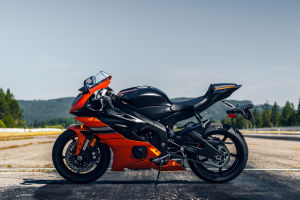Motorcycles, operating through gasoline engines and steered by handlebars for swift maneuverability, have served as versatile vehicles for various purposes, including patrolling, transportation, and sports.
Their extensive categorization encompasses street, road racing, off-road, cruiser, and touring models.
The motorcycle engine, often characterized by its gasoline-powered mechanism, has a storied history dating back to 1885. It was in this year that Gottlieb Daimler accomplished a remarkable feat by assembling an engine onto a frame, thereby giving birth to the world's inaugural motorcycle.
This invention laid the groundwork for motorcycle sports, engaging in competitive events featuring two or three-wheeled variants, classified by varying engine capacities and encompassing diverse races such as off-road challenges, multi-day endurance tests, road races, track-based competitions, and adventurous tours, with rankings determined by speed or skillful driving.
Over more than a century, motorcycles have undergone a remarkable evolution since Daimler's pioneering invention. The original prototype, now preserved at Munich's Science and Technology Museum and patented by Daimler on August 29, 1885, stands as a testament to the vast differences in appearance, structure, and performance when compared to modern-day motorcycles.
Constrained by the technological limitations prevalent over a century ago, the initial motorcycle featured a wooden frame and wheels enveloped in iron cladding, propelled by a single-cylinder fan-cooled engine that generated minimal power—equivalent to a mere fraction of today's standard motorcycles.
Operating at a modest speed of 12km/h, slightly surpassing a pedestrian's pace, it earned the moniker "bone-shaker" due to its jarring ride quality on the rudimentary roads of the 19th century.
Despite its rudimentary nature, this prototype paved the way for continual refinement and innovation in the motorcycle industry. It served as the precursor to the modern motorcycles that have proliferated globally, exceeding billions in number over the past century.
With a shifting global focus toward sustainability, the motorcycle industry is embracing the trend of electrification. BMW Motorrad, among others, has set ambitious long-term goals, aiming to electrify its entire urban mobility range by the year 2030.
This transition toward electric-powered motorcycles heralds a definitive future. However, it poses challenges such as elevated production costs, nascent supply chains, and a reshaped competitive landscape—a series of crucial hurdles for motorcycle manufacturers to navigate in this era of transformation.
The journey of motorcycles, from their humble wooden-framed origins to today's billion-strong industry, reflects an unparalleled evolution in transportation. While the pioneering "bone-shaker" paved the way, modern motorcycles have transcended boundaries, becoming symbols of speed, freedom, and adventure.
As the world pivots towards sustainability, the imminent shift to electric motorcycles marks a pivotal chapter. Despite challenges, manufacturers are forging ahead, envisioning a future where innovation meets environmental consciousness. The legacy of motorcycles, rooted in innovation and adaptability, continues to ride the winds of change, promising an electrifying future on the roads ahead.

